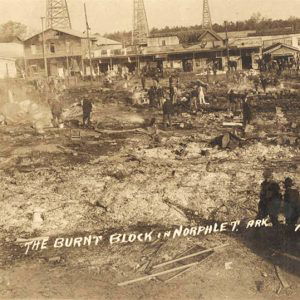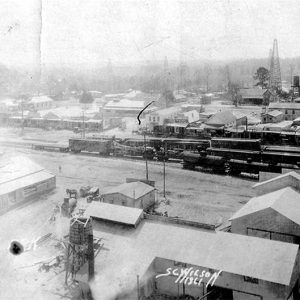calsfoundation@cals.org
Norphlet (Union County)
|
Latitude and Longitude: |
|
|
Elevation: |
180 feet |
|
Area: |
2.04 square miles (2020 Census) |
|
Population: |
766 (2020 Census) |
|
Incorporation Date: |
July 27, 1923 |
Historical Population as per the U.S. Census:
|
1810 |
1820 |
1830 |
1840 |
1850 |
1860 |
1870 |
1880 |
1890 |
1900 |
|
– |
– |
– |
– |
– |
– |
– |
– |
– |
– |
|
1910 |
1920 |
1930 |
1940 |
1950 |
1960 |
1970 |
1980 |
1990 |
2000 |
|
– |
– |
1,063 |
695 |
653 |
459 |
755 |
756 |
706 |
822 |
|
2010 |
2020 | ||||||||
|
844 |
766 |
The city of Norphlet, like nearby Smackover (Union County) and El Dorado (Union County), rose to prominence due to the oil industry. The city is home to one of the most notorious disasters in Arkansas’s history of oil drilling. More recently, however, it has become a bedroom community to El Dorado, the county seat.
The forested hills of Union County were thinly populated until after the Civil War and Reconstruction. The railroad industry, combined with the timber industry, brought new life to the area. The St. Louis, Iron Mountain and Southern Railway built a line running from Gurdon (Clark County) through El Dorado that was completed in January 1891. Norphlet was one of several depots created along the railway. The timber industry was prominent in the settlement of Norphlet for the first thirty years of its existence.
The town was reportedly named for Nauphlet Goodwin, but the name Nauphlet was misspelled as Norphlet by the Postal Department when the town’s post office was created in 1891. Norphlet was actually the third name selected for the small settlement: its post office was first designated Haymos and then Jess before becoming Norphlet, all in the same year.
The oil boom in Union County exploded with particular force in Norphlet. Seeking to tap into the Smackover Oil Field, workers for Oil Operators Trust were drilling a well in Norphlet designated Murphy No. 1. On May 14, 1922, their drilling struck a large pocket of natural gas, which began to escape at a rate estimated at around 65 to 75 million cubic feet of gas per day. Efforts to cap the hole were ineffective, and, on the morning of May 16, the gas ignited, shooting flames more than 300 feet into the air and creating a crater at least 450 feet across and 75 feet deep. The explosion and fire, which demolished the oil derrick, sent fragments of shale up to ten miles away from Norphlet. A second well, drilled a few weeks later in an effort to reduce the fuel supply of the fire, also caught fire and created a second crater. But the oil industry continued to thrive in Union County, as the Smackover field was successfully tapped in other locations.
Many oil workers came to Norphlet and the other communities of the area, and hotels, taverns, and other businesses quickly arose. Prostitution and gambling were prevalent, and law enforcement only gradually began to establish order in the region. Norphlet was incorporated as a town in 1923 and elevated to a second-class city in 1925.
One of the city leaders, Bob Williams, seemed familiar with law enforcement, hiring lawyer Pat McNalley to represent the city in its efforts to organize. (Oil company leaders, seeking to avoid taxation, were opposing the incorporation.) Williams avoided publicity for his efforts, reportedly hiding his face under his hat on one occasion when city leaders were photographed. After he left Norphlet, rumors circulated that he had ties to the Belle Starr gang. He reportedly became a police officer in Kilgore, Texas, but died while resisting arrest after robbing a bank in Louisiana.
Norphlet established a school that by 1926 was rated one of the best in Arkansas. The population fluctuated at first but became more stable when the MacMillan Oil Refinery was established in the city. The oil refinery closed in 1987; the property was bought by Nor-Ark Industrial Corporation but was abandoned in 1991. Oil had contaminated surrounding waters, leading the Environmental Protection Agency to clean up the site through its national Superfund program; the clean-up was completed in 1997.
The oil industry continues to provide most of the jobs in the city in the twenty-first century. Consolidation caused some of the smaller rural schools in Union County to be closed but brought more students into Norphlet. In 2013, the school district reported about 200 students in the elementary school and about 200 students in the high school. The city supports a few small businesses, stores, and churches. The crater from the 1922 explosion, now filled with water, is surrounded by a fence to prevent accidents. It was added to the National Register of Historic Places in 2008.
For additional information:
Buckalew, A. R., and R. B. Buckalew. “The Discovery of Oil in South Arkansas, 1920–1924.” Arkansas Historical Quarterly 33 (Autumn 1974): 195–238.
Cordell, Anna Harmon. Dates and Data of Union County, Arkansas, 1541–1948. Monroe-Lafayette, LA: Century Printing & Publishing, Inc., 1984.
Hull, Clifton E. Railroad Stations and Trains through Arkansas and the Southwest. Hart, MO: Whiteriver Productions, Inc., 1997.
Steven Teske
Butler Center for Arkansas Studies
 Norphlet Depot
Norphlet Depot  Norphlet Fire
Norphlet Fire  Norphlet View
Norphlet View  Union County Map
Union County Map 



Comments
No comments on this entry yet.